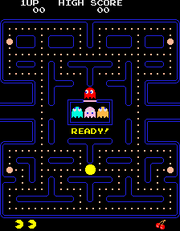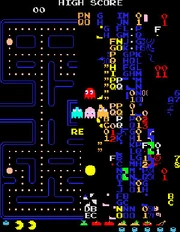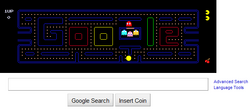| Pac-Man | |
| Developer: | Namco |
| Publisher: | Namco/Bally Midway |
| Series: | Pac-Man series |
| Genres: | Maze |
| Release date(s): | |
| Arcade system | Namco Pac-Man |
| Number of players | One or two players |
| Input methods | 4 way joystick |
side of the photo
Pac-Man (known as Puck-Man in Japan) is a popular game in the USA and Japan. It was first created by Toru Iwatani and released by Namco/Midway. It consists of a yellow partial-pizza-shaped Pac-Man who eats dots inside a blue maze.
History

Original American artwork.
Pac-Man is an arcade game created by Toru Iwatani and released by Namco in May 22, 1980 under the name "Puck-Man". The name of the game was later changed to "Pac-Man" due to vandalism of the "P" in "Puck" into an offensive word. The game wasn't intended to be too popular at first, but when released, the game was a huge success. This resulted in many sequels of the game, including Ms. Pac-Man. The game has been cloned innumerable times, and re-released in many compilations.
Gameplay
The player controls a circular character which has a pie wedge shaped mouth to eat pellets through a maze, eating Pac-Dots. When all dots are eaten, Pac-Man is taken to the next stage. Four ghosts, Blinky, Pinky, Inky and Clyde roam the maze, trying to catch Pac-Man. If a ghost chomps (touches) Pac-Man, a life is lost. When all lives have been lost, the game ends. Pac-Man is awarded a single bonus life at 10,000 points by default–DIP switches inside the machine can change the required points or disable the bonus life altogether.
Near the corners of the maze are four larger, flashing dots known as Power Pellets, provide Pac-Man with the temporary ability to eat the ghosts. The ghosts turn deep blue, reverse direction, and move slower when Pac-Man eats one. When a ghost is eaten, its eyes return to the ghost home where it is regenerated in its normal color. Blue ghosts flash white before they become dangerous again and the amount of time the ghosts remain vulnerable varies from one round to the next, but the time period generally becomes shorter as the game progresses. In later stages, the ghosts don't change colors at all, but still reverse direction when a power pellet is eaten.
In addition to Pac-Dots and Power Pellets, bonus items, usually referred to as fruits (though not all items are fruits) appear near the center of the maze. These items score extra bonus points when eaten. The items change and bonus values increase throughout the game. Sometimes, items can appear several times. Also, a series of intermissions play after certain levels toward the beginning of the game, showing a humorous set of interactions (the first being after level 2, which has a giant Pac-Man chasing a blue Blinky) between Pac-Man and Blinky. Intermissions: #1: Giant Pac-Man vs Blue Blinky. #2: Blinky chases Pac-Man, but gets cut on a white stick. #3: Number 3 has Blinky, who's wound has been glued on again, chase Pac-Man, but his entire slime (body) fall off! Intermission 3 is used as all other intermissions after.

The original maze.
Scoring System
- Pac-Dot - 10 points.
- Power Pellet - 50 points.
- Vulnerable Ghosts:
- #1 in succession - 200 points.
- #2 in succession - 400 points.
- #3 in succession - 800 points.
- #4 in succession - 1600 points.
- Fruit:
- Cherry: 100 points.
- Strawberry: 300 points
- Orange: 500 points
- Apple: 700 points
- Melon: 1000 points
- Galxian Boss: 2000 points
- Bell: 3000 points
- Key: 5000 points

Original arcade Japanese instruction card
Ghosts
The four ghosts, formerly known as "monsters", are the enemies in the original arcade game. They cycle through different "modes" of behavior, colloquially known as "scatter"–where they retreat to the four corners of the maze–and "chase"–where their A.I. kicks in. Each ghost has unique A.I., programmed so that the game would not get impossibly difficult or boring. There are certain one-way areas on the maze–namely, the two "T" formations located directly above and below the Ghost Home (the box in the center of the stage)–that the ghosts can travel down through, but can't go up through. There are also two entrances to a tunnel on either side of the maze that Pac-Man can travel through and come out the opposite side of the screen on, which will slow the ghosts down if they enter it. Yet another advantage Pac-Man has over the quartet is that he can turn slightly faster. Once each ghosts' mannerisms are fully learned, they can be easily manipulated by the player to get a very high score. Here is a breakdown of each ghosts' behavior when in chase mode, generally speaking:
- the red ghost, Blinky, doggedly pursues Pac-Man;
- the pink ghost, Pinky, tries to ambush Pac-Man by moving parallel to him;
- the cyan ghost, Inky, tends not to chase Pac-Man directly unless Blinky is near;
- the orange ghost, Clyde, pursues Pac-Man when far from him, but usually wanders away when he gets close.
Here is a set of all of the ghosts' character names (hinting at their behavior), and nicknames. (The alternate names for Puck-Man are triggered through a DIP switch.)
| Color | Puck-Man | Pac-Man | ||||
|---|---|---|---|---|---|---|
| Character | Nickname | Alternate character |
Alternate nickname |
Character | Nickname | |
| Red | Oikake | Akabei | Urchin | Macky | Shadow | Blinky |
| Pink | Machibuse | Pinky | Romp | Micky | Speedy | Pinky |
| Cyan | Kimagure | Aosuke | Stylist | Mucky | Bashful | Inky |
| Orange | Otoboke | Guzuta | Crybaby | Mocky | Pokey | Clyde |
Split-screen level

When the player gets to the 256th level, the right side of the maze becomes a garbled mess of code, therefore making the level impossible. The right side has some Pac-Dots too, but only 9. The right side of the screen also traps the ghosts and can make Pac-Man go off the screen. The left side of the maze remains fine though. If one uses a hack to skip the level, then the game goes back to the first level. Because of this bug, a perfect game only counts the first 255 levels. This is more commonly known as a kill screen.
Home consoles
Pac-Man first appeared on home consoles in 1981. The game has been released for the following systems and devices.
1981 - Atari 2600, Atari 800
1982 – Atari 5200, Atari 8-bit
1983 – Apple II, Intellivision
1984 – Nintendo Entertainment System, MSX
1990 – Game Boy
1991 – Game Gear
1999 – Neo Geo Pocket Color, Game Boy Color
2003 – Mobile
2006 – Xbox Live Arcade, iPod Classic
2007 – Virtual Console
2010 – Windows Phone 7
2011 - iPhone/iPad
2013 - Wii U
In other games
As well as being included in several compilations, the first Pac-Man is also featured in some newer games in the series. The following Pac-Man games contain the original arcade version.
Namco Museum variation
This version of the game, introduced in Namco Museum Volume 1 (1995), is notable for being perhaps the most frequently rereleased "official" version of Pac-Man from 1995 to 2005. It is mostly faithful to the arcade version, but a few things were altered in gameplay. Whether these changes were intentional or not has yet to be addressed.
- Pinky's target is always exactly four spaces in front of Pac-Man (in the original, this changed slightly when Pac-Man was facing up, due to an overflow bug).
- Inky now relies on Blinky exclusively as a target, making Inky more predictable.
- The ghosts' eyes will not travel up through the one-way paths when returning to regenerate.
- When a ghost is sent back to the Ghost Home to regenerate, they will always come back out instantly, even if Pac-Man lost a life on the current round. (Incidentally, this fixes a glitch that can occur in the original wherein Pac-Man can "trap" Pinky, Inky, and Clyde in the Ghost Home.)
- Ghosts can "voluntarily" exit the Ghost Home to the right if their target happens to be there (in the original, they will never exit to the right unless the "mode" changes while they are in the Ghost Home).
- If a bonus fruit appears and Pac-Man eats a ghost, the timer that controls how long the fruit stays onscreen halts with everything else. This makes it impossible for fruit to disappear while Pac-Man is eating a ghost.
There were also a few cosmetic changes:
- In most home console versions of this port, a digital screen overlay based off of the original Puck-Man overlay artwork (albeit with a shorter nose) is placed on the left and right sides of the gameplay screen to occupy the unused space.
- All Midway copyright information was removed from the introduction screen and replaced with Namco copyright information. Additionally, the ghosts' "character" names on the introduction screen now feature hyphens after the name instead of before.
This version of Pac-Man was featured in the following games after its initial release:
- Namco Museum 64 - 1999
- Pac-Man World - 1999
- Namco Museum (Dreamcast) - 2000
- Namco Museum (PS2, Gamecube, Xbox) - 2001
- Pac-Man Collection - 2001
- Pac-Man World 2 - 2002
- Pac-Man World 3 - 2005
- Namco Museum Battle Collection - 2005
- Pac-Man World Rally - 2006
Most versions of Pac-Man after 2005 are direct emulations of the arcade version rather than ports (with references to Midway removed); as such, the ghosts all behave as they originally did, and any patterns applicable to the original version will work on these. The Namco Museum 50th Anniversary and Xbox Live Arcade versions were among of the first of them–the latter updated the screen overlay featured in Puck-Man, this time using comparable artwork from Pac-Man World.
Trivia
- Pac-Man is a very popular video game, thus it appears in many television shows such as iCarly appearing as "Pak-Rat", Square One TV as "Mathman", and Tiny Toon Adventures as "Plane-Man". The game itself has appeared in shows such as Family Guy, The Simpsons, Mad and Robot Chicken.
- The game has inspired many unofficial clones and remakes. Both amateurs and commerical game designers have created unauthorised Pac-Man games and even characters named Pac-Man.
- The original design for the American Pac-Man characters were rather deformed looking and very different from the characters seen today. The original design had no arms or hands - they were launched in the United States but were replaced shortly after the launch-date.
- There is a game, 3-Demon, which is obviously a rip off of Pac-Man, where the player eats dots and a power pellet turns all the ghosts (who are red) green.
- In Jak 3, Daxter gets teleported to the Matrix where he is in a Pac-Man styled game.

Google's Pac-Man game as their logo to celebrate Pac-Man's 30th anniversary.
- For the game's 30th anniversary, Google briefly updated their homepage on May 21, 2010 for 48 hours to allow players to play a version of Pac-Man in a maze based off of the Google Logo. This version plays exactly like the original (including Ghost A.I.), but with the following differences:
- If "Insert Coin" is clicked after the game has started, the Ms. Pac-Man theme plays and two players may then play cooperatively as Pac-Man and Ms. Pac-Man. The two play exactly the same except for sound effects made when munching dots.
- The maze, as aforementioned, is derived from the Google logo, and it is no longer symmetrical.
- There are five power pellets instead of four.
- The Google version of Pac-Man has been made permanently available here.
- Toru Iwatani states in a Yahoo Article , that the ghosts were all almost the same color, red. All the ghosts were red in Pac-Man's appearance in Futrama however. Toru refused the order and on questionnaires to the game testers asking if they would want a single-colored ghost instead of one, none wanted a single-color.

The picture of Mimas's daytime temperatures.
- A pattern in a Saturn moon called Mimas's daytime temperatures takes the shape of Pac-Man in a NASA picture.
- In Hungama (an Indian television channel), there is a game called Hungamaze in which Hungaman is Pac-Man and the Villains are Ghosts.
- There is a rare glitch where Pac-Man can surprisingly go through ghosts.
- Pac-Man, Pac-Man Plus, and Pac-Man Arrangement are the only games in the series to formally feature the ghosts' "character" names.
- The Namco Classic Collection Vol. 2 version of Pac-Man featured a mix of the Puck-Man alternate character names and the Pac-Man nicknames as the new default for international audiences. This is the only version of the game to do so, as any other versions either port over the Pac-Man or Puck-Man default names (for worldwide and Japan, respectively).
- The Xbox Live Arcade version of Pac-Man features an arcade cabinet in the background of its title screen. It is quite clearly based off of the Puck-Man cabinet, but taking a closer look at it will show that all instances of "Puck-Man" are replaced with "Pac-Man", and all of the art of Pac-Man on the cabinet has a shorter nose (not unlike the Namco Museum overlay art).
Gallery
External links
- The Pac-Man Dossier – an in-depth look at the game mechanics of Pac-Man











